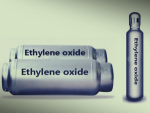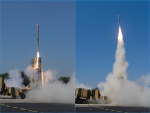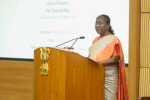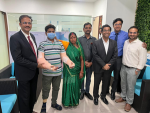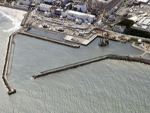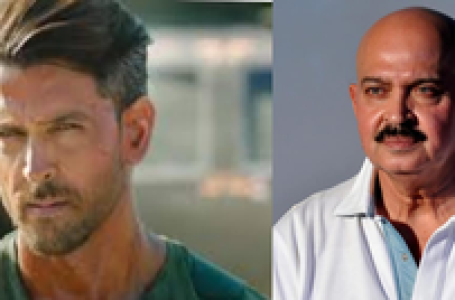
By Niruj Mohan Ramanujam
April 11, 2019
Chennai: The Event Horizon Telescope has released the first direct image of a black hole and its neighbourhood. This black hole lurks in the centre of a nearby galaxy called M87. This historic image shows a ring of light coming from the gas falling into the black hole. The black hole itself is shielded by the event horizon, a boundary from within which nothing can escape, and this is the dark interior in the image. Though astronomers have had solid evidence for the existence of massive black holes for many years, this historic moment marks the first time that it has been imaged.
What has the Event Horizon Telescope seen?
The Event Horizon Telescope, or EHT, has imaged the silhouette or shadow of the black hole at the centre of M87, a galaxy 55 million light years from us. To make this image, astronomers combined data from 8 different telescopes across the world in an experiment in April 2017. The data was taken at a frequency of 230 GHz, or a wavelength of 1.3 mm. Using this, astronomers have formed an image of the black hole for the first time. The event horizon of a black hole is the ultimate boundary. Nothing from within it can escape out. The ring of fire in the EHT image is light from the gas falling into the event horizon, whose shadow is the dark hole in the centre. The exact shape of the ring is due to the way the incredible gravity of the black hole bends the light around it, and the incredible speed at which the gas is travelling is why the ring is not uniform in brightness.
How big is the black hole at the centre of M87?
Almost all galaxies have black holes at their centres, and these can be a few million to a few billion times the mass of our Sun. Our Milky Way galaxy has a fairly small black hole about 4 million times as massive as our Sun. However, the black hole in M87 is a monster, and is 6500 million times the mass of the Sun. The size of its event horizon is about 20000 million km, which even bigger than our Solar System.
A black hole does not emit any light. Then how do astronomers ‘see’ it or its shadow?
Matter is attracted by the gravity of a black hole, but cannot fall into it easily. In fact, it forms a swirling disk around it, through which it spirals in to the black hole at extremely high speed. While doing so, matter gets heated to enormous temperatures, and this hot magnetised plasma is what emits the intense radiation that we see.
EHT has got an image of the radiation from this surrounding gas at a frequency of 230 GHz. However, the image is not as simple as a dark hole in front of a disk of radiating gas. Since the gravity near the black hole is immense, it can bend the path of the light rays from the surrounding magnetised plasma in peculiar ways. So even light from the gas behind the black hole bends enough to reach us. This bending of the light, called gravitational lensing, determines the final shape of the ring and the inner shadow that the EHT has imaged.
Why are black holes and their images so important?
Black holes can test physics theories such as the General Relativity theory of Einstein, which relates the motion of bodies due to gravity with the curvature of spacetime. It has passed every test in our Solar System (the accuracy of GPS in our phones is also a good test of the theory) as well as in other astronomical objects. All this is called the weak gravity case where the curvature of spacetime is small. What astronomers want to do is to test the theory in strong gravity, where the curvature is much higher, and see if the theory still works. The recent detection of gravitational waves from merging black holes is one such example. Imaging the shadow of super-massive black holes in galactic centres is another.
(India Science Wire)




